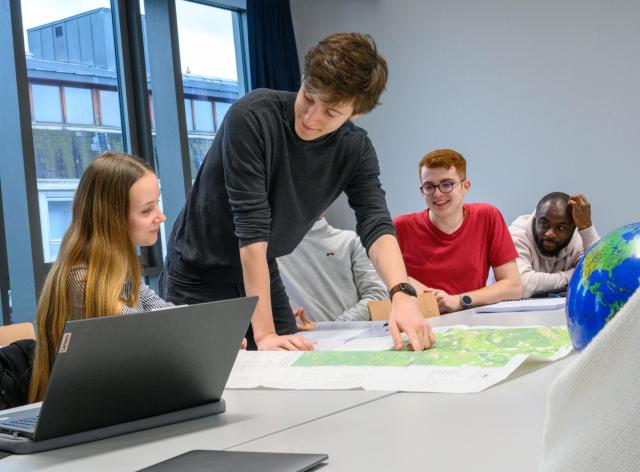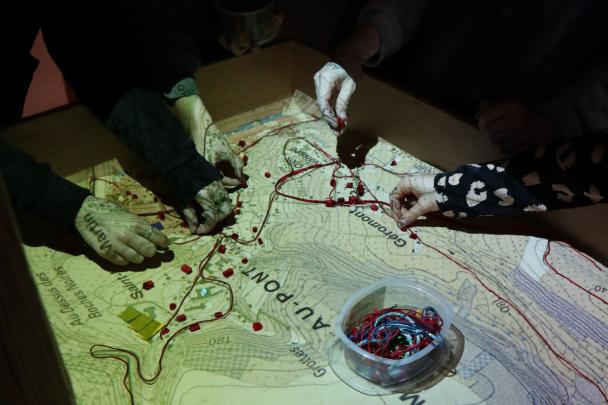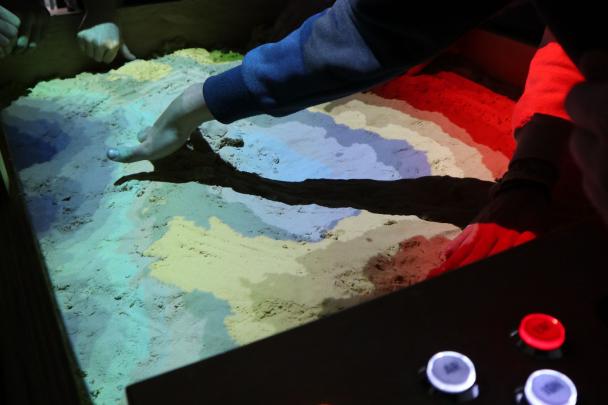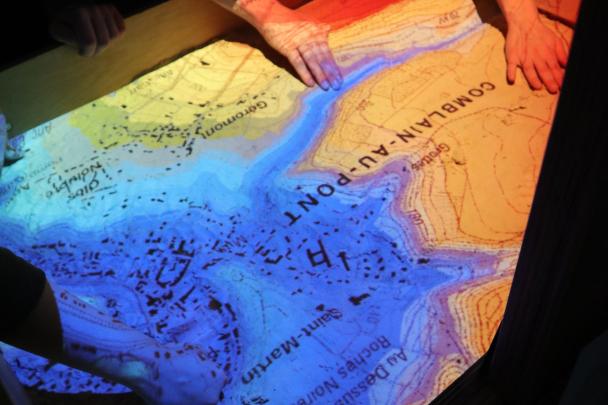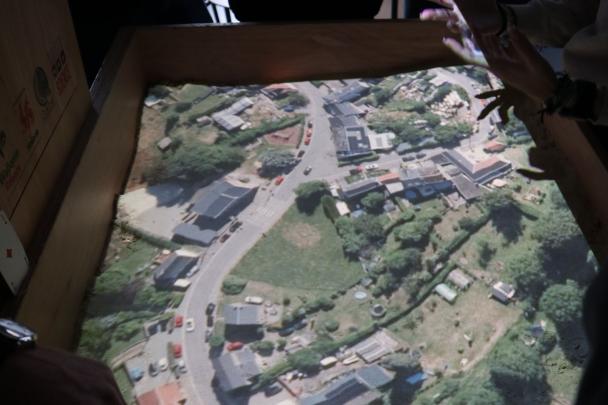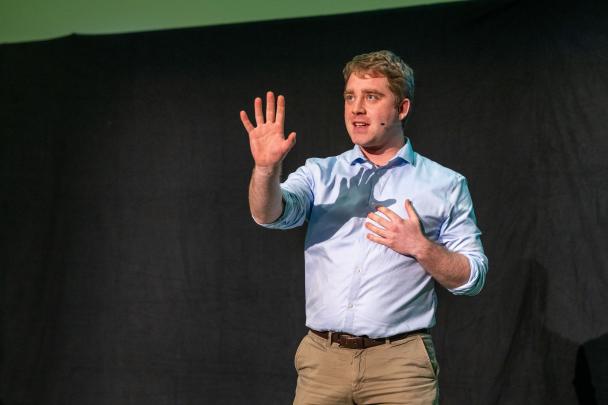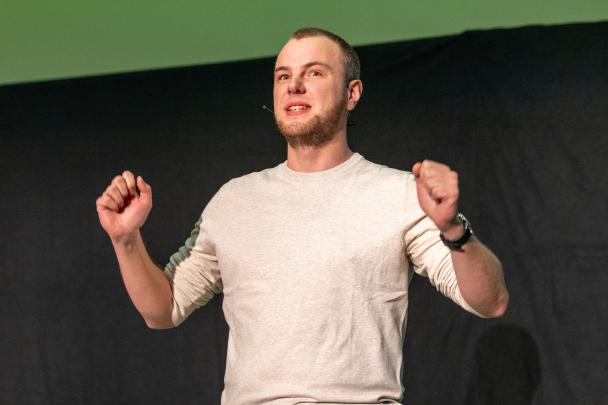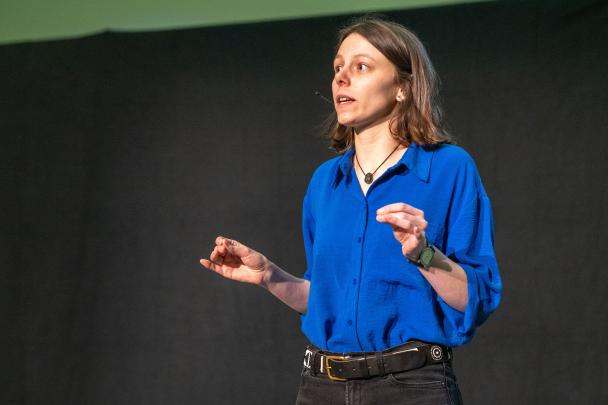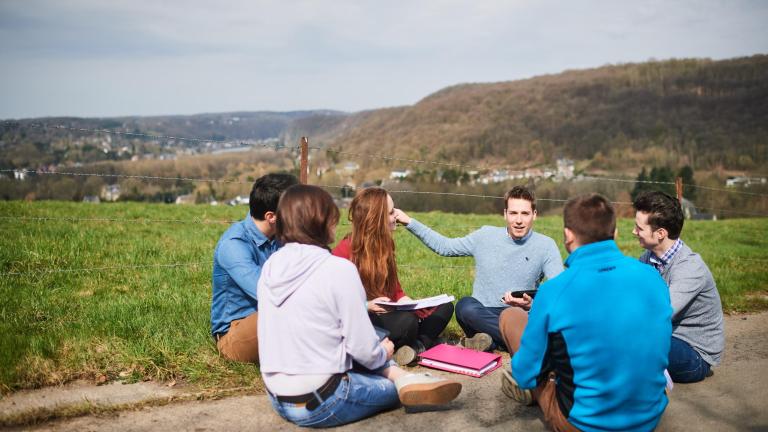Geography is concerned with the interactions between man and the environment, and the processes that influence these interactions, such as urbanization, agriculture, mobility, trade, globalization and climate change. A science of action, geography offers a framework for reflection and tools to guide decision-makers towards sustainable solutions, thus promoting the harmonious development of societies and the preservation of the environment.
.Geography is a committed science. It explores, deciphers and improves the organization of our environment, thus contributing to a better developed and more sustainable planet.
Geographers, with their unique perspective, examine the complex links between man and his habitat. They go beyond the simple questions of "where" and "at what scale", looking at the reasons for "why here rather than elsewhere?" and ways of optimizing the management of space.
At the crossroads of the natural and social sciences, geography occupies a central position, proposing comprehensive and thoughtful solutions to questions of location. It does not content itself with theories, but implements modern tools such as computerized cartography, geographic information systems, remote sensing, satellite imagery and data analysis.
That's not all: geography goes beyond theory by putting these tools at the service of spatial planning, technical cooperation and development aid policies, demonstrating its commitment to humanity.
Geographers observe and analyze territories, organizations, individuals and ecosystems in order to understand them, to grasp their complexity and then to propose solutions.
Discover the geographer's professions in our newsroom article...
Find out more about the Geography Department
Spotlight
News

Two complementary points of view to put environmental protection back at the heart of public debate
Two complementary points of view to put environmental protection back at the heart of public debate
The University of Namur is soon to offer two inaugural lessons for two Francqui Chairs, one in the Faculty of Science and the other in the Faculty of Law. Open to all, the inaugural lectures will be followed by a local drink. These events are free, upon registration.

Chaire Francqui 2025-2026 en sciences | Repairing our relationship with Nature to transform our societies
The biodiversity crisis isn't just destroying nature: it's also threatening our societies, our well-being and our survival. Based on the scientific assessments and findings of the IPBES (Intergovernmental Science-Policy Platform on Biodiversity and Ecosystem Services), this Francqui Chair will explore our toxic relationship with nature, the global failure to protect it, and the multiple values of living things.
Speaker: Sander Jacobs, Senior Researcher at INBO (Institute for Nature and Forestry), Nature & Society research group, Coordinator of the Urban Nature research program and Visiting Professor at Ghent University.
19/11/2025 - Inaugural lecture | Biodiversity crisis: causes, consequences, and how (not) to get out of it.
Francqui 2025-2026 Chair in Law | Need for environment, need for law?
This Francqui Chair offers a fresh look at the advances but also the tensions that today characterize the way the law organizes society's relationship with the environment. If the ambition to protect the environment has indeed become a legal issue, how are its essential mainsprings evolving, whether in climate matters, in the relationship to human health, or in the status accorded to nature?
The organization of this Chair is fully integrated into the Law School's Fil Rouge 2025-2026 dedicated to this substratum essential to life that is the environment, nature, our earth: "Réenchanter la terre".
Orator: Delphine Misonne, Senior Research Fellow FNRS, Professor at UCLouvain, Director of CEDRE and member of the Royal Academy of Belgium.
27/11/2025 - Inaugural Lesson I Protecting the environment beyond politics
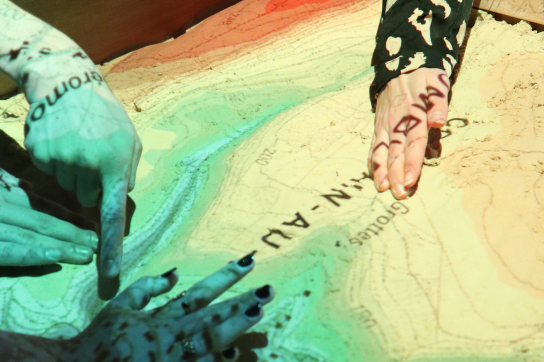
Flood prevention: an innovative teaching activity for geography students
Flood prevention: an innovative teaching activity for geography students
How does a river work? How do river overflows occur? What can be done to protect our territories from these risks? At UNamur, geography students followed an innovative teaching activity, using a 3D augmented reality sandbox, to learn about this issue. What are the aims of this tool? Simulate and analyze natural phenomena. A unique and immersive experience to better understand environmental dynamics and climate risks, carried out in collaboration with the non-profit organization Contrat de Rivière Ourthe.
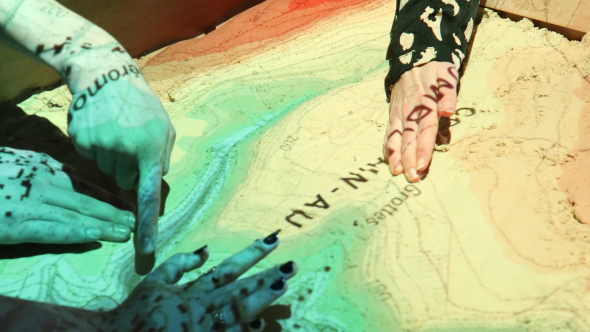
In early October, it was with their hands in the sand that Bac 2 and Bac 3 students from UNamur's Geography Department were able to gain a very concrete understanding of the flooding mechanism. "This activity was organized in partnership with the asbl Contrat de Rivière Ourthe," explains Sébastien Dujardin, teacher-researcher in the Geography Department. "Our students had the opportunity to use a 3D augmented reality sandbox, developed as part of the EXACT LAB project (Exploration 3D et Adaptation aux Conséquences des Changements Climatiques sur un Territoire)", he details.
During this activity, students modeled the relief by hand and simulated virtual rainfall to observe runoff on the ground, thanks to 3D Kinect technology. Various layers of geographic information, such as topographic maps, aerial photos and runoff maps, were then projected onto the relief to further the reflection.
Students were able to explore how rivers work, concepts related to flooding (return period, amount of precipitation, hydrometry, etc.), and analyze the territorial issues most at risk (schools, homes, roads). They also discussed and tested various planning measures, such as hedge planting, the creation of stormwater basins and ditches, taking into account natural and human constraints.
"This activity was an excellent opportunity for our students to develop their risk culture, essential in the face of the growing challenges of drought and flooding," Sébastien Dujardin points out again. "The topic of flooding is more topical than ever and represents a major societal challenge. It perfectly illustrates our educational approach: observe, understand and act to better harmonize human activities with an ever-changing environment," he concludes.
Combining theory and practice: a winning combo for students
Alison Castremanne student in Bac 3 Geography
"This activity highlighted the importance of participatory planning and management involving the various stakeholders in the territory to deal with issues such as flooding. For example, we found that anti-flooding practices implemented upstream can have a significant impact on flows downstream. Modeling through this activity has enabled us to visualize in concrete terms the flows and preventive practices adapted to the geographical context (topography, location of villages in relation to slopes, budgetary constraints, etc.). What I particularly appreciate about UNamur is the dynamism of the training, which combines enriching practical activities (field days, workshops, group work) with high-quality theoretical teaching. What's more, the proximity and commitment of the professors and assistants offer attentive and enriching support for students."
Léo Raymond student in BAC3 geography
"The "sandbox" tool helped me understand that a territory is never uniform: development that is conceivable across a commune is not at all so 5 km away. From this point of view, it's very important to analyze what's around us and react accordingly to avoid too much damage."
What fascinates me about my studies in geography is the diversity of the subject we tackle. Whether it's environmental, anthropocentric or even economic, everything is tackled and this enables us to build up a very important knowledge base for the future."
Geography at UNamur
Are you interested in studying geography? Find out more about our training courses!
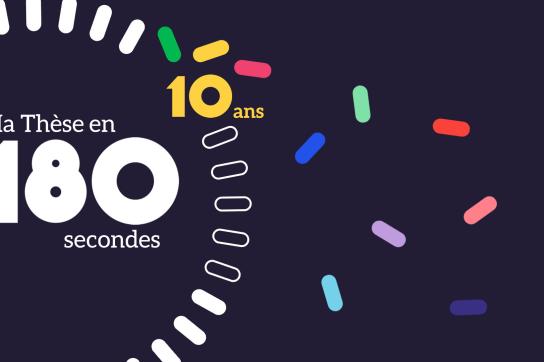
10 years of the MT180 competition: 3 UNamur candidates take part in the national final in Brussels
10 years of the MT180 competition: 3 UNamur candidates take part in the national final in Brussels
On March 24, 2024, the tenth edition of the MT180 competition, a French-language competition for the popularization of science, took place at UNamur. Two physicists and a geographer represented our university at the national final, held in Brussels on May 16.
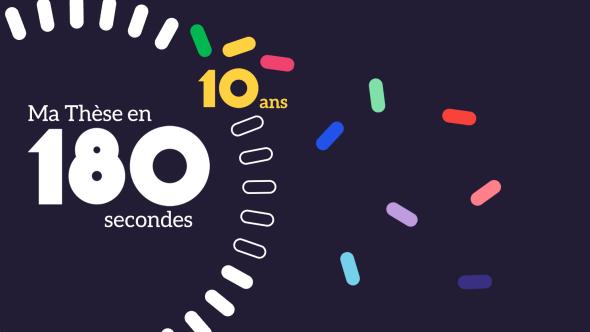
The Confluent des Savoirs, local organizers of the event, wanted to focus on one of the societal missions of research: popularized communication to a wide audience.
Annick Castiaux, Rector of UNamur, introduced the competition with the rediscovery of a sequence from the 1998 program Matière Grise, in which she presented, in two minutes, the objective of her research in optical physics. Encouraging young researchers to learn how to communicate in lay terms, Annick Castiaux stressed the need to adapt codified scientific discourse to reduce the distance between university research and other players in society. Presented by Aline Wilmet of Confluent des Savoirs, the event was an opportunity to explore the history of the competition at UNamur and to exchange experiences with former candidates.
This year, 12 candidates took part in this local final: Manel Barkallah (computer science), Louis Rassinfosse (physics), Charline Focant (biology), Guillaume Nguyen (computer science), Yves Blanco Alvarez (biology), Alexandra Decloux (veterinary medicine), Adélie Lannoy (biology), Loris Chavée (physics), Yasmine Akaichi (computer science), Valentin Job (physics), Antoine Hubermont (computer science) and Camille Morlinghem (geography).
Their performances were enthusiastically received by the audience: 280 people gathered in the Rosalind Franklin auditorium to discover the latest in interdisciplinary research and its societal challenges. In order to prepare them optimally for the demands of the competition and those of their thesis or lecture defense, candidates benefited from training in popularized communication, the construction of a structured pitch, as well as appropriate speaking and body language.
The candidates' pitches were evaluated by a jury of professionals in the field of scientific communication and popularization: Géraldine Tran, editor-in-chief of Athena, SPW's science mag; Nathan Uyttendaele, statistician and web popularizer via his YouTube channel "Chat Sceptique"; Charlotte Benedetti, director of Pavillon (KIKK asbl) in Namur and François-Xavier Fiévez, pedagogue, didactician and improviser, Vice-Rector for Student and Social Affairs at UNamur.
The 3 UNamur winners
The People's Choice Award went to Louis Rassinfosse for his pitch "Les nanoparticules: ces artisans des couleurs", left in photo. The second jury prize went to Loris Chavée for his pitch "Sun, film and foam .... an energy cocktail!", right in photo. The jury's first prize went to Camille Morlinghem for his pitch "Map me if you can", in the center of the photo.
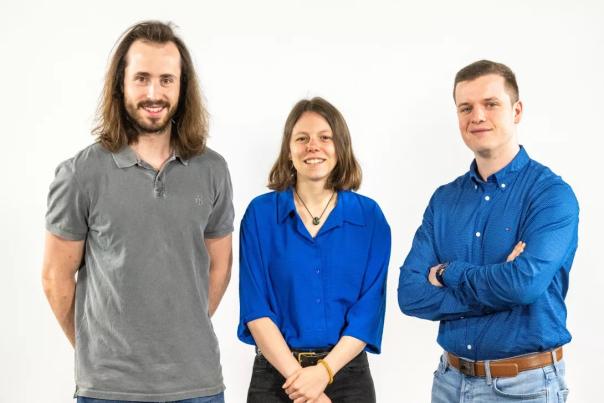
The regional competition is the first step in the MT180 adventure. The three winners from Namur will represent UNamur at the national final to be held on May 16 at the Solbosch campus in Brussels. The winner will represent Belgium this autumn at the international final in Abidjan (Ivory Coast).
The 2024 national final
On May 16, 2024, we'll be celebrating 10 years of the MT180 competition at the national finals to be held on ULB's Solbosch campus in Brussels. At this event, 15 PhD students, including the 3 UNamur prizewinners, will take up the challenge of popularizing their thesis topic with clarity to captivate an uninformed audience, in 3 minutes flat!
The jury will be made up of 6 personalities from French-speaking universities, the press and the world of popular science. The winner will represent Belgium at the international competition to be held in Abidjan, Côte d'Ivoire, the week of November 18, 2024.
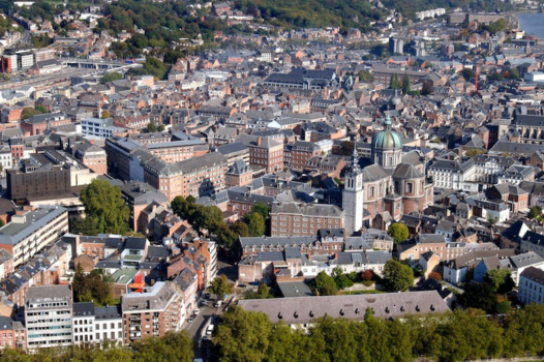
Discover the city of Namur through urban trails
Discover the city of Namur through urban trails
Namur, a capital city at the confluence of the Sambre and Meuse rivers, in the heart of Wallonia. Its history, geography and architecture make it an attractive city and an ideal place for secondary school students to discover the city.
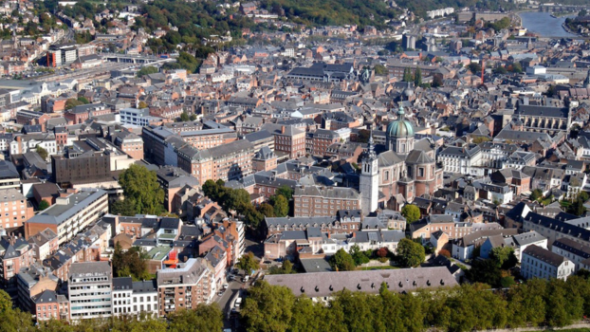
Initier à la lecture et à l'interprétation d'un territoire urbain fait partie des nombreux objectifs du CEFOSCIM, le centre de Formation Continuée en Sciences et Mathématique de l'UNamur. Pour cela, une équipe de passionnés a développé les « Parcours urbains », un outil de lecture des paysages urbains ludique, à destination des enseignants en étude du milieu et de leur classe de 1e et 2e secondaire.
Pour cela, neuf parcours dans le centre-ville de Namur ont été créés. Ces itinéraires illustrent les différentes phases d’urbanisation dans laquelle la ville s’est construite. Ce dispositif permet d'utiliser le paysage comme porte d'entrée privilégiée des apprentissages des six piliers du cours d'EDM, à savoir habiter, circuler, consommer, se cultiver, produire et vivre en société.
Découvrez ce dispositif en images
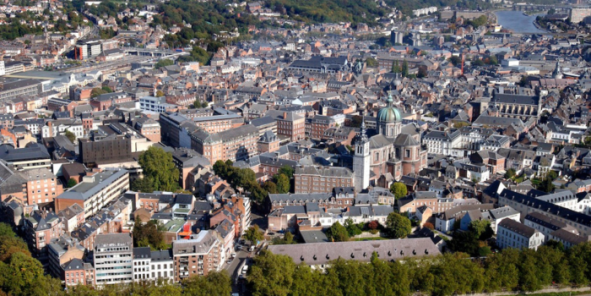
En pratique, comment cela fonctionne ?
Une fois l’activité présentée par le professeur, les élèves sont invités à découvrir leur carnet de terrain et les cartes du parcours avec le trajet qu’ils devront suivre dans Namur.
Une fois que les élèves ont reçu les instructions et consignes de sécurité, ils peuvent se rendre dans la ville par groupe de quatre, en totale autonomie. Accompagnés d’un guide et d’un référentiel, ils vont pouvoir découvrir la ville, tout en endossant des rôles bien précis : l’élève GPS gérera l’itinéraire et la lecture de la carte, le secrétaire lira les questions et complètera le carnet de terrain, le photographe prendra les photos requises et l’horloge veillera au timing de la sortie.
Durant une heure, les élèves auront l’occasion d’analyser l’architecture des bâtiments, leur fonctionnalité, la disposition des rues, la circulation, les usagers présents (piétons, vélos…) dans les différents quartiers, le vocabulaire urbain… Mais ils seront aussi amenés à réfléchir sur l’avenir de la ville en termes de développement durable.
De retour en classe, c’est l’heure du débriefing. Chaque groupe raconte son expérience vécue sur le terrain. Les enseignants leur proposent alors d’aller plus loin grâce à une mise en situation. Ainsi, les élèves sont amenés à réaliser une brochure pour un office de tourisme contenant un itinéraire de promenade commenté. Ces apprentissages impliquent l’élève et lui permettent de développer son autonomie, la recherche d’information, sa structuration et sa communication. Ces quatre points forment les piliers des compétences d’un cours d’étude du milieu.
« Les enseignants sont séduits par la démarche », se réjouit Christian Jacques, formateur au CEFOSCIM et collaborateur didactique au Département de géographie. « Grâce à ce dispositif, ils ont la possibilité de sortir sur leur terrain avec leur classe et réaliser une activité où leurs élèves sont en totale autonomie. On leur offre une activité préparée et des outils pour aller plus loin sur la thématique de l’analyse des paysages urbains. »
Les avantages de ces parcours sont nombreux : l’expérience par les sens, confronter l’élève au réel, ancrer les apprentissages dans sa mémoire sensorielle, les responsabiliser. Les sorties sur le terrain sont aussi l’occasion de pousser les jeunes à redécouvrir le milieu au travers de problématiques actuelles et de créer du lien entre eux. Les parcours urbains s’inscrivent dans la pédagogie actuelle et active et placent l’élève au cœur de son apprentissage.
Une activité proposée par le CEFOSCIM
Centre de Formation Continuée en Sciences et Mathématique de l'Université de Namur (CEFOSCIM) regroupe les activités des différents départements de la Faculté des sciences.
Depuis 2008, leur domaine d'activité principal est la mise en place de formations continues dédiées aux enseignants du secondaire. Le CEFOSCIM couvre toutes les matières scientifiques enseignées (chimie, biologie, physique, mathématique et géographie) dans le respect des programmes. Fort de son expérience, il a également développé des outils pédagogiques uniques !
Le centre organise également des formations continues (animaux de laboratoire, biosécurité, ateliers du paysage, etc.) et des certificats d'université (CUBEA) destinés à d'autres publics.

Two complementary points of view to put environmental protection back at the heart of public debate
Two complementary points of view to put environmental protection back at the heart of public debate
The University of Namur is soon to offer two inaugural lessons for two Francqui Chairs, one in the Faculty of Science and the other in the Faculty of Law. Open to all, the inaugural lectures will be followed by a local drink. These events are free, upon registration.

Chaire Francqui 2025-2026 en sciences | Repairing our relationship with Nature to transform our societies
The biodiversity crisis isn't just destroying nature: it's also threatening our societies, our well-being and our survival. Based on the scientific assessments and findings of the IPBES (Intergovernmental Science-Policy Platform on Biodiversity and Ecosystem Services), this Francqui Chair will explore our toxic relationship with nature, the global failure to protect it, and the multiple values of living things.
Speaker: Sander Jacobs, Senior Researcher at INBO (Institute for Nature and Forestry), Nature & Society research group, Coordinator of the Urban Nature research program and Visiting Professor at Ghent University.
19/11/2025 - Inaugural lecture | Biodiversity crisis: causes, consequences, and how (not) to get out of it.
Francqui 2025-2026 Chair in Law | Need for environment, need for law?
This Francqui Chair offers a fresh look at the advances but also the tensions that today characterize the way the law organizes society's relationship with the environment. If the ambition to protect the environment has indeed become a legal issue, how are its essential mainsprings evolving, whether in climate matters, in the relationship to human health, or in the status accorded to nature?
The organization of this Chair is fully integrated into the Law School's Fil Rouge 2025-2026 dedicated to this substratum essential to life that is the environment, nature, our earth: "Réenchanter la terre".
Orator: Delphine Misonne, Senior Research Fellow FNRS, Professor at UCLouvain, Director of CEDRE and member of the Royal Academy of Belgium.
27/11/2025 - Inaugural Lesson I Protecting the environment beyond politics

Flood prevention: an innovative teaching activity for geography students
Flood prevention: an innovative teaching activity for geography students
How does a river work? How do river overflows occur? What can be done to protect our territories from these risks? At UNamur, geography students followed an innovative teaching activity, using a 3D augmented reality sandbox, to learn about this issue. What are the aims of this tool? Simulate and analyze natural phenomena. A unique and immersive experience to better understand environmental dynamics and climate risks, carried out in collaboration with the non-profit organization Contrat de Rivière Ourthe.

In early October, it was with their hands in the sand that Bac 2 and Bac 3 students from UNamur's Geography Department were able to gain a very concrete understanding of the flooding mechanism. "This activity was organized in partnership with the asbl Contrat de Rivière Ourthe," explains Sébastien Dujardin, teacher-researcher in the Geography Department. "Our students had the opportunity to use a 3D augmented reality sandbox, developed as part of the EXACT LAB project (Exploration 3D et Adaptation aux Conséquences des Changements Climatiques sur un Territoire)", he details.
During this activity, students modeled the relief by hand and simulated virtual rainfall to observe runoff on the ground, thanks to 3D Kinect technology. Various layers of geographic information, such as topographic maps, aerial photos and runoff maps, were then projected onto the relief to further the reflection.
Students were able to explore how rivers work, concepts related to flooding (return period, amount of precipitation, hydrometry, etc.), and analyze the territorial issues most at risk (schools, homes, roads). They also discussed and tested various planning measures, such as hedge planting, the creation of stormwater basins and ditches, taking into account natural and human constraints.
"This activity was an excellent opportunity for our students to develop their risk culture, essential in the face of the growing challenges of drought and flooding," Sébastien Dujardin points out again. "The topic of flooding is more topical than ever and represents a major societal challenge. It perfectly illustrates our educational approach: observe, understand and act to better harmonize human activities with an ever-changing environment," he concludes.
Combining theory and practice: a winning combo for students
Alison Castremanne student in Bac 3 Geography
"This activity highlighted the importance of participatory planning and management involving the various stakeholders in the territory to deal with issues such as flooding. For example, we found that anti-flooding practices implemented upstream can have a significant impact on flows downstream. Modeling through this activity has enabled us to visualize in concrete terms the flows and preventive practices adapted to the geographical context (topography, location of villages in relation to slopes, budgetary constraints, etc.). What I particularly appreciate about UNamur is the dynamism of the training, which combines enriching practical activities (field days, workshops, group work) with high-quality theoretical teaching. What's more, the proximity and commitment of the professors and assistants offer attentive and enriching support for students."
Léo Raymond student in BAC3 geography
"The "sandbox" tool helped me understand that a territory is never uniform: development that is conceivable across a commune is not at all so 5 km away. From this point of view, it's very important to analyze what's around us and react accordingly to avoid too much damage."
What fascinates me about my studies in geography is the diversity of the subject we tackle. Whether it's environmental, anthropocentric or even economic, everything is tackled and this enables us to build up a very important knowledge base for the future."
Geography at UNamur
Are you interested in studying geography? Find out more about our training courses!

10 years of the MT180 competition: 3 UNamur candidates take part in the national final in Brussels
10 years of the MT180 competition: 3 UNamur candidates take part in the national final in Brussels
On March 24, 2024, the tenth edition of the MT180 competition, a French-language competition for the popularization of science, took place at UNamur. Two physicists and a geographer represented our university at the national final, held in Brussels on May 16.

The Confluent des Savoirs, local organizers of the event, wanted to focus on one of the societal missions of research: popularized communication to a wide audience.
Annick Castiaux, Rector of UNamur, introduced the competition with the rediscovery of a sequence from the 1998 program Matière Grise, in which she presented, in two minutes, the objective of her research in optical physics. Encouraging young researchers to learn how to communicate in lay terms, Annick Castiaux stressed the need to adapt codified scientific discourse to reduce the distance between university research and other players in society. Presented by Aline Wilmet of Confluent des Savoirs, the event was an opportunity to explore the history of the competition at UNamur and to exchange experiences with former candidates.
This year, 12 candidates took part in this local final: Manel Barkallah (computer science), Louis Rassinfosse (physics), Charline Focant (biology), Guillaume Nguyen (computer science), Yves Blanco Alvarez (biology), Alexandra Decloux (veterinary medicine), Adélie Lannoy (biology), Loris Chavée (physics), Yasmine Akaichi (computer science), Valentin Job (physics), Antoine Hubermont (computer science) and Camille Morlinghem (geography).
Their performances were enthusiastically received by the audience: 280 people gathered in the Rosalind Franklin auditorium to discover the latest in interdisciplinary research and its societal challenges. In order to prepare them optimally for the demands of the competition and those of their thesis or lecture defense, candidates benefited from training in popularized communication, the construction of a structured pitch, as well as appropriate speaking and body language.
The candidates' pitches were evaluated by a jury of professionals in the field of scientific communication and popularization: Géraldine Tran, editor-in-chief of Athena, SPW's science mag; Nathan Uyttendaele, statistician and web popularizer via his YouTube channel "Chat Sceptique"; Charlotte Benedetti, director of Pavillon (KIKK asbl) in Namur and François-Xavier Fiévez, pedagogue, didactician and improviser, Vice-Rector for Student and Social Affairs at UNamur.
The 3 UNamur winners
The People's Choice Award went to Louis Rassinfosse for his pitch "Les nanoparticules: ces artisans des couleurs", left in photo. The second jury prize went to Loris Chavée for his pitch "Sun, film and foam .... an energy cocktail!", right in photo. The jury's first prize went to Camille Morlinghem for his pitch "Map me if you can", in the center of the photo.

The regional competition is the first step in the MT180 adventure. The three winners from Namur will represent UNamur at the national final to be held on May 16 at the Solbosch campus in Brussels. The winner will represent Belgium this autumn at the international final in Abidjan (Ivory Coast).
The 2024 national final
On May 16, 2024, we'll be celebrating 10 years of the MT180 competition at the national finals to be held on ULB's Solbosch campus in Brussels. At this event, 15 PhD students, including the 3 UNamur prizewinners, will take up the challenge of popularizing their thesis topic with clarity to captivate an uninformed audience, in 3 minutes flat!
The jury will be made up of 6 personalities from French-speaking universities, the press and the world of popular science. The winner will represent Belgium at the international competition to be held in Abidjan, Côte d'Ivoire, the week of November 18, 2024.

Discover the city of Namur through urban trails
Discover the city of Namur through urban trails
Namur, a capital city at the confluence of the Sambre and Meuse rivers, in the heart of Wallonia. Its history, geography and architecture make it an attractive city and an ideal place for secondary school students to discover the city.

Initier à la lecture et à l'interprétation d'un territoire urbain fait partie des nombreux objectifs du CEFOSCIM, le centre de Formation Continuée en Sciences et Mathématique de l'UNamur. Pour cela, une équipe de passionnés a développé les « Parcours urbains », un outil de lecture des paysages urbains ludique, à destination des enseignants en étude du milieu et de leur classe de 1e et 2e secondaire.
Pour cela, neuf parcours dans le centre-ville de Namur ont été créés. Ces itinéraires illustrent les différentes phases d’urbanisation dans laquelle la ville s’est construite. Ce dispositif permet d'utiliser le paysage comme porte d'entrée privilégiée des apprentissages des six piliers du cours d'EDM, à savoir habiter, circuler, consommer, se cultiver, produire et vivre en société.
Découvrez ce dispositif en images

En pratique, comment cela fonctionne ?
Une fois l’activité présentée par le professeur, les élèves sont invités à découvrir leur carnet de terrain et les cartes du parcours avec le trajet qu’ils devront suivre dans Namur.
Une fois que les élèves ont reçu les instructions et consignes de sécurité, ils peuvent se rendre dans la ville par groupe de quatre, en totale autonomie. Accompagnés d’un guide et d’un référentiel, ils vont pouvoir découvrir la ville, tout en endossant des rôles bien précis : l’élève GPS gérera l’itinéraire et la lecture de la carte, le secrétaire lira les questions et complètera le carnet de terrain, le photographe prendra les photos requises et l’horloge veillera au timing de la sortie.
Durant une heure, les élèves auront l’occasion d’analyser l’architecture des bâtiments, leur fonctionnalité, la disposition des rues, la circulation, les usagers présents (piétons, vélos…) dans les différents quartiers, le vocabulaire urbain… Mais ils seront aussi amenés à réfléchir sur l’avenir de la ville en termes de développement durable.
De retour en classe, c’est l’heure du débriefing. Chaque groupe raconte son expérience vécue sur le terrain. Les enseignants leur proposent alors d’aller plus loin grâce à une mise en situation. Ainsi, les élèves sont amenés à réaliser une brochure pour un office de tourisme contenant un itinéraire de promenade commenté. Ces apprentissages impliquent l’élève et lui permettent de développer son autonomie, la recherche d’information, sa structuration et sa communication. Ces quatre points forment les piliers des compétences d’un cours d’étude du milieu.
« Les enseignants sont séduits par la démarche », se réjouit Christian Jacques, formateur au CEFOSCIM et collaborateur didactique au Département de géographie. « Grâce à ce dispositif, ils ont la possibilité de sortir sur leur terrain avec leur classe et réaliser une activité où leurs élèves sont en totale autonomie. On leur offre une activité préparée et des outils pour aller plus loin sur la thématique de l’analyse des paysages urbains. »
Les avantages de ces parcours sont nombreux : l’expérience par les sens, confronter l’élève au réel, ancrer les apprentissages dans sa mémoire sensorielle, les responsabiliser. Les sorties sur le terrain sont aussi l’occasion de pousser les jeunes à redécouvrir le milieu au travers de problématiques actuelles et de créer du lien entre eux. Les parcours urbains s’inscrivent dans la pédagogie actuelle et active et placent l’élève au cœur de son apprentissage.
Une activité proposée par le CEFOSCIM
Centre de Formation Continuée en Sciences et Mathématique de l'Université de Namur (CEFOSCIM) regroupe les activités des différents départements de la Faculté des sciences.
Depuis 2008, leur domaine d'activité principal est la mise en place de formations continues dédiées aux enseignants du secondaire. Le CEFOSCIM couvre toutes les matières scientifiques enseignées (chimie, biologie, physique, mathématique et géographie) dans le respect des programmes. Fort de son expérience, il a également développé des outils pédagogiques uniques !
Le centre organise également des formations continues (animaux de laboratoire, biosécurité, ateliers du paysage, etc.) et des certificats d'université (CUBEA) destinés à d'autres publics.


